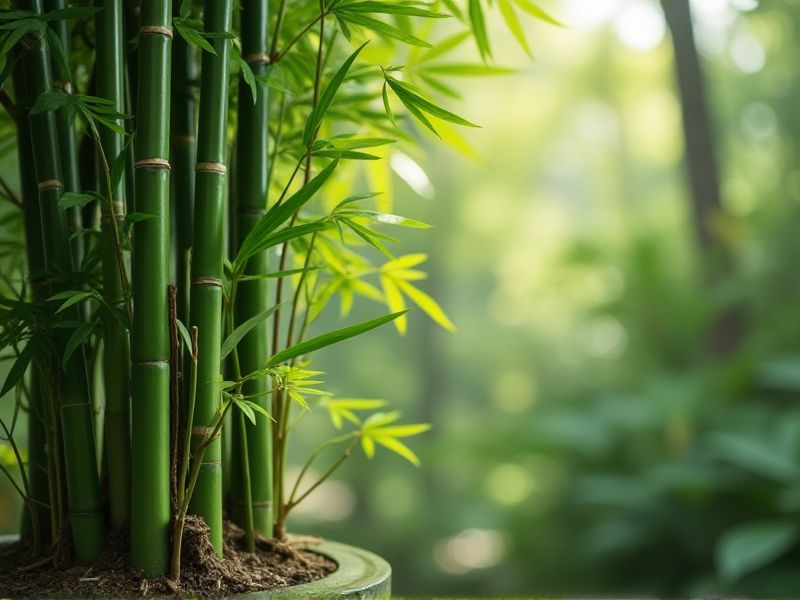
Bamboo plants that thrive indoors, such as Lucky Bamboo (Dracaena sanderiana), are known for their air-purifying qualities and low maintenance requirements. These fast-growing plants prefer indirect sunlight and do well in water or well-draining soil, making them an ideal choice for home and office settings. Your indoor bamboo will flourish in temperatures ranging from 60degF to 80degF, and regular misting helps mimic its natural humid habitat. Fertilizing every few weeks with a balanced liquid fertilizer can enhance growth and vitality. Common pests like spider mites and mealybugs can be controlled with insecticidal soap, ensuring your bamboo remains healthy and vibrant.
List of some Bamboo plants that grow indoors
- Lucky Bamboo (Dracaena sanderiana)
- Dwarf Bamboo (Pleioblastus pygmaeus)
- Umbrella Bamboo (Fargesia murielae)
- Pygmy Bamboo (Pleioblastus distichus)
- Heavenly Bamboo (Nandina domestica)
- Alphonse Karr Bamboo (Bambusa multiplex)
- Golden Bamboo (Phyllostachys aurea)
- Black Bamboo (Phyllostachys nigra)
- Temple Bamboo (Semiarundinaria fastuosa)
- Buddha's Belly Bamboo (Bambusa ventricosa)
Important things about Bamboo plants that grow indoors
Ideal Lighting Conditions
Bamboo plants thrive best in bright, indirect light, making them perfect for indoor environments. Direct sunlight can scorch their leaves, so situate your bamboo near east-facing windows where they can receive filtered sunlight. If natural light is limited, artificial grow lights offering the full spectrum can effectively supplement their lighting needs. Maintaining optimal light conditions will ensure your indoor bamboo remains healthy and vibrant, promoting growth and lush foliage.
Temperature Requirements
Bamboo plants thriving indoors prefer a temperature range of 65degF to 85degF (18degC to 29degC), ensuring optimal growth and health. These plants are sensitive to extreme temperature fluctuations, so maintaining consistent warmth is crucial for their development. Providing indirect sunlight and avoiding drafty areas will help maintain the ideal environment for your indoor bamboo. Regularly monitoring temperature and humidity levels can further enhance your bamboo's vitality and aesthetic appeal in your living space.
Humidity Preferences
Bamboo plants thrive in indoor environments with humidity levels ranging from 40% to 60%, making them well-suited for bathrooms or kitchens where moisture is naturally higher. To enhance humidity, consider using a pebble tray filled with water beneath the pot or misting the leaves regularly with water. Investing in a small humidifier can also help maintain optimal conditions, especially in dry climates or during winter months when indoor air tends to be drier. By providing the right humidity, you can ensure your bamboo remains vibrant and healthy, promoting its growth and overall longevity.
Soil Type Selection
For growing bamboo indoors, selecting the right soil type is crucial to ensure healthy growth and vibrant foliage. A well-draining soil mix is ideal, typically composed of a blend of potting soil, peat moss, and perlite to provide adequate aeration and moisture retention. Bamboo thrives in slightly acidic to neutral pH levels, so incorporating organic matter like compost can enhance nutrient availability. Regularly checking soil moisture is essential, as bamboo prefers consistently moist conditions without becoming waterlogged.
Watering Frequency
Bamboo plants thrive in well-draining soil, which necessitates careful consideration of watering frequency. For indoor bamboo, you should water when the top inch of the soil feels dry to the touch, typically every 1 to 2 weeks depending on the humidity and temperature of your environment. Overwatering can lead to root rot, while underwatering may cause leaves to yellow and drop. Ensure your bamboo receives bright, indirect light to promote healthy growth and optimal moisture retention.
Fertilization Guidelines
Bamboo plants thriving indoors benefit from a balanced liquid fertilizer high in nitrogen, phosphorus, and potassium, typically in a ratio of 20-20-20. Applying this fertilizer every four to six weeks during the growing season, which is spring and summer, encourages robust growth and vibrant foliage. You should always dilute the fertilizer according to package instructions to prevent root burn and ensure the health of your plant. It's important to monitor the bamboo for signs of nutrient deficiency, such as yellowing leaves, indicating that adjustments to your fertilization schedule may be necessary.
Pruning Techniques
Pruning bamboo plants that thrive indoors is essential for maintaining their health and aesthetics. Regularly trimming the faded or yellowing leaves encourages new growth and improves air circulation, which is vital for preventing diseases. You can also control the size of the bamboo by cutting back the stalks, ensuring they remain proportional to your indoor space. Utilize sharp, clean pruning shears to make precise cuts, which helps to reduce stress on the plant and promotes a lush, vibrant appearance.
Pest Management
Bamboo plants thrive in indoor environments, offering a unique aesthetic while requiring specific care to prevent pest infestations. Common pests include spider mites, aphids, and mealybugs, which can harm your bamboo by sucking sap and weakening its growth. To manage these pests, regularly inspect your plants for signs of infestation and maintain humidity levels, as bamboo prefers a humid atmosphere that deters many harmful insects. Organic treatments such as neem oil or insecticidal soap can effectively eliminate pests without harming your indoor bamboo's health.
Growth Habit And Height
Bamboo plants that thrive indoors typically exhibit a compact growth habit, making them ideal for limited spaces. Most indoor varieties, like the Lucky Bamboo (Dracaena sanderiana), can reach heights of 2 to 4 feet, while maintaining a slender appearance. Their rapid growth rate allows you to enjoy lush greenery quickly, often requiring periodic pruning to manage their size. When providing care, ensure your bamboo receives bright, indirect light and regular watering to promote healthy development.
Benefits For Indoor Air Quality
Bamboo plants are exceptional for enhancing indoor air quality, as they actively filter pollutants such as formaldehyde, benzene, and carbon monoxide. With their fast growth rate and high transpiration capacity, these plants effectively increase humidity levels, promoting a healthier environment in your home. Bamboo also absorbs carbon dioxide and releases oxygen, which can improve overall respiratory health for you and your family. Furthermore, their natural aesthetic adds a touch of serenity and style to your indoor spaces.
